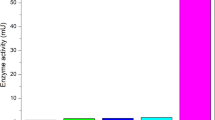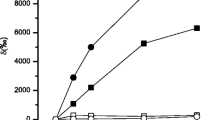Abstract
Extracts of denitrifying bacteria grown anaerobically with phenol and nitrate catalyzed an isotope exchange between 14CO2 and the carboxyl group of 4-hydroxybenzoate. This exchange reaction is ascribed to a novel enzyme, phenol carboxylase, initiating the anaerobic degradation of phenol by para-carboxylation to 4-hydroxybenzoate. Some properties of this enzyme were determined by studying the isotope exchange reaction. Phenol carboxylase was rapidly inactivated by oxygen; strictly anoxic conditions were essential for preserving enzyme activity. The exchange reaction specifically was catalyzed with 4-hydroxybenzoate but not with other aromatic acids. Only the carboxyl group was exchanged; [U-14C]phenol was not exchanged with the aromatic ring of 4-hydroxybenzoate. Exchange activity depended on Mn2+ and inorganic phosphate and was not inhibited by avidin. Ortho-phosphate could not be substituted by organic phosphates nor by inorganic anions; arsenate had no effect. The pH optimum was between pH 6.5–7.0. The specific activity was 100 nmol 14CO2 exchange · min-1 · mg-1 protein. Phenol grown cells contained 4-hydroxybenzoyl CoA synthetase activity (40 nmol · min-1 · mg-1 protein). The possible role of phenol carboxylase and 4-hydroxybenzoyl CoA synthetase in anaerobic phenol metabolism is discussed.
Similar content being viewed by others
References
Bak F, Widdel F (1986) Anaerobic degradation of phenol and phenol derivatives by Desulfobacterium phenolicum sp. nov. Arch Microbiol 146:177–180
Balba MT, Evans WC (1980) The methanogenic biodegradation of catechol by a microbial consortium: evidence for the production of phenol through cis-benzene-diol. Biochem Soc Trans 8:452–453
Benziman M, Heller N (1964) Oxaloacetate decarboxylation and oxaloacetate-carbon dioxide exchange in Acetobacter xylinum. J Bacteriol 88:1678–1687
Berry DF, Francis AJ, Bollag JM (1987) Microbial metabolism of homocyclic and heterocyclic aromatic compounds under anaerobic conditions. Microbiol Rev 51:43–59
Dimroth P (1987) Sodium ion transport decarboxylases and other aspects of sodium ion cycling in bacteria. Microbiol Rev 51:320–340
Evans WC, Fuchs G (1988) Anaerobic degradation of aromatic compounds. Annu Rev Microbiol 42:289–317
Genthner BR Sharak, Price II WA, Pritchard PH (1989) Anaerobic degradation of chloroaromatic compounds in aquatic sediments under a variety of enrichment conditions. Appl Environ Microbiol 55:1466–1471
Glöckler R, Tschech A, Fuchs G (1989) Reductive dehydroxylation of 4-hydroxybenzoyl-CoA to benzoyl-CoA in a denitrifying phenol degrading Pseudomonas species. FEBS Lett 251:237–240
Knoll G, Winter J (1987) Anaerobic degradation of phenol in sewage sludge. Benzoate formation from phenol and CO2 in the presence of hydrogen. Appl Microbiol Biotechnol 25:384–391
Knoll G, Winter J (1989) Degradation of phenol via carboxylation to benzoate by a defined, obligate syntrophic consortium of anaerobic bacteria. Appl Microbiol Biotechnol 30:318–324
Krumholz LR, Crawford RL, Hemling ME, Bryant MP (1987) Metabolism of gallate and phloroglucinol in Eubacterium oxidoreducens via 3-hydroxy-5-oxohexanoate. J Bacteriol 169:1886–1890
Kuhn EP, Suflita JM, Rivera MD, Young LY (1989) Influence of alternate electron acceptors on the metabolic fate of hydroxybenzoate isomers in anoxic aquifer slurries. Appl Environ Microbiol 55:590–598
Merkel SM, Eberhard AE, Gibson J, Harwood CS (1989) Involvement of coenzyme A thioesters in anaerobic metabolism of 4-hydroxybenzoate by Rhodopseudomonas palustris. J Bacteriol 121:1–7
Nozawa T, Maruyama Y (1988) Anaerobic metabolism of phthalate and other aromatic compounds by a denitrifying bacterium. J Bacteriol 170:5778–5784
Rabinowitz JC, Allen EH (1961) Role of vitamin B12 derivatives in reactions of pyruvate. Fed Proc Fed Am Soc Exp Biol 20:962–966
Schink B, Tschech A (1988) Fermentative degradation of aromatic compounds. In: Hagedorn SR, Hanson RS, Kunz DA (eds) Microbial metabolism and the carbon cycle. Harwood Academic Publishers, Chur London Paris New York Melbourne, pp 213–226
Szewzyk U, Schink B (1989) Degradation of hydroquinone, gentisate, and benzoate by a fermenting bacterium in pure or defined mixed culture. Arch Microbiol 151:541–545
Szewzyk U, Szewzyk R, Schink B (1985) Methanogenic degradation of hydroquinone and catechol via reductive dehydroxylation to phenol. FEMS Microbiol Ecol 31:79–87
Tschech A (1989) The anaerobic degradation of aromatic compounds (in German). Forum Mikrobiologie 12:251–264
Tschech A, Fuchs G (1987) Anaerobic degradation of phenol by pure cultures of newly isolated denitrifying pseudomonads. Arch Microbiol 148:213–217
Tschech A, Schink B (1986) Fermentative degradation of monohydroxybenzoates by defined syntrophic cocultures. Arch Microbiol 145:396–402
Vance GF, Boyd SA, Mokma DL (1985) Extraction of phenolic compounds from a spodosol profile: an evaluation of three extractants. Soil Sci 140:412–420
Webster LT, Mieyal JJ, Siddiqui UA (1974) Benzoyl and hydroxybenzoyl esters of coenzyme A. Ultraviolet characterization and reaction mechanisms. J Biol Chem 249:2641–2645
Whittle PJ, Lunt DO, Evans WC (1976) Anaerobic photometabolism of aromatic compounds by Rhodopseudomonas sp. Biochem Soc Trans 4:490–491
Young LY (1984) Anaerobic degradation of aromatic compounds. In: Gibson DT (ed) Microbial degradation of organic compounds. Marcel Dekker, New York, pp 487–523
Young LY, Rivera MD (1985) Methanogenic degradation of four phenolic compounds. Water Res 19:1325–1332
Ziegler K, Braun K, Böckler A, Fuchs G (1987) Studies on the anaerobic degradation of benzoic acid and 2-aminobenzoic acid by a denitrifying Pseudomonas strain. Arch Microbiol 149: 62–69
Ziegler K, Buder R, Winter J, Fuchs G (1989) Activation of aromatic acids and aerobic 2-aminobenzoate metabolism in a denitrifying Pseudomonas strain. Arch Microbiol 151:171–176
Author information
Authors and Affiliations
Rights and permissions
About this article
Cite this article
Tschech, A., Fuchs, G. Anaerobic degradation of phenol via carboxylation to 4-hydroxybenzoate: in vitro study of isotope exchange between 14CO2 and 4-hydroxybenzoate. Arch. Microbiol. 152, 594–599 (1989). https://doi.org/10.1007/BF00425493
Received:
Accepted:
Issue Date:
DOI: https://doi.org/10.1007/BF00425493




